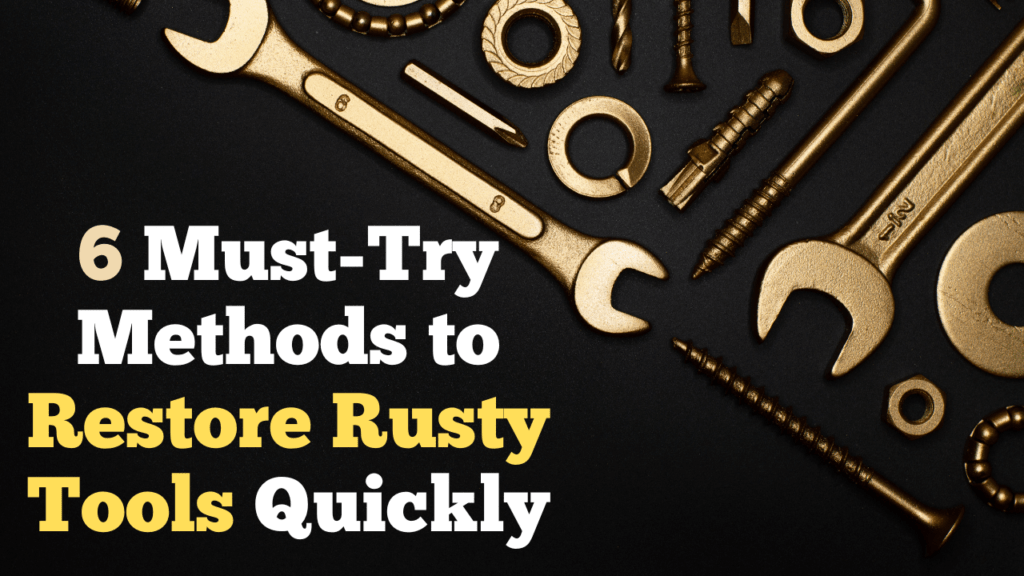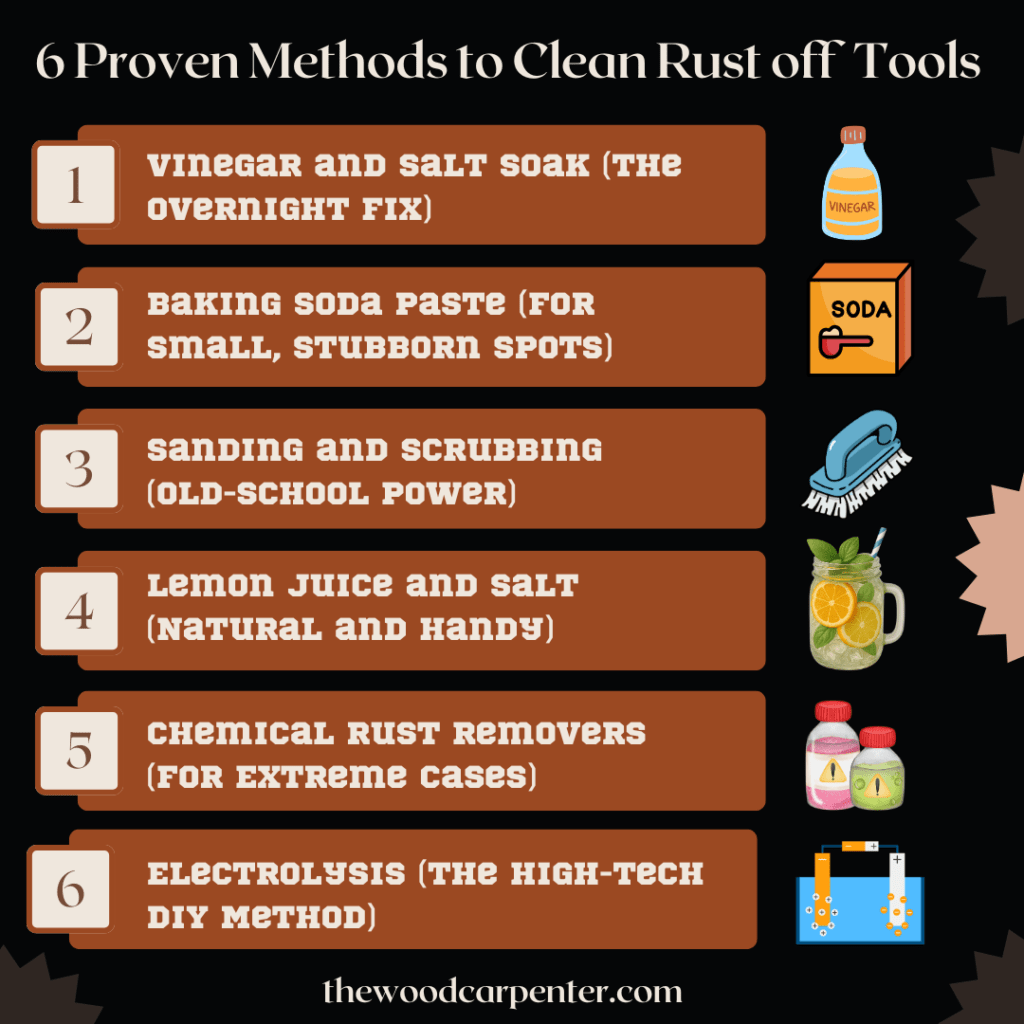
Every DIYer and gardener knows the frustration of picking up tools they depend on only to discover they’ve become discolored with rust. Rust makes tools look old and weak, and, left unchecked, can eat away at their useful metal components and become dangerous weapons against future DIY projects.
But here’s the good news: Restoring rusty tools doesn’t need to involve fancy equipment or harsh chemicals – with patience and some household items you can bring them back to life! Over the years I’ve tried various rust removal strategies such as soaking them in vinegar to using baking soda paste scrubbers; some methods may require extra elbow grease while others work just as easily.
In this guide, I’ll outline six tried-and-tested techniques to quickly restore rusty tools while offering prevention tips so that it doesn’t happen again in the near future.
Why Tools Rust in the First Place
Rust is is simply iron oxide and it is formed when metal reacts with oxygen and moisture in its environment, typically through exposure to moisture or damp environments like sheds or soil storage facilities.
Even humid air can initiate this process. Although rust may look ugly or reduce performance, early intervention often means easy treatment solutions are available.
6 Proven Methods to Clean Rust off of Tools:
1. Vinegar and Salt Soak (The Overnight Fix)
If you want a low-effort solution, this one’s a winner.
How it works: The acetic acid in vinegar reacts with iron oxide (rust), softening and lifting it away. Adding salt makes the reaction stronger.
Steps:
- In an enclosed container, submerge your tool completely in white vinegar.
- Add about 1/4 cup of salt per liter of vinegar for extra kick.
- Allow it to soak for 12-24 hours for light rust or up to three days for heavy buildup.
- Clean off loose rust with steel wool or a scouring pad.
- Neutralize by immersing for 10 minutes in a baking soda solution.
- Dry the area completely before applying a thin coating of oil.
Personal tip: I once soaked a rust-covered adjustable wrench for two days. When I pulled it out, most of the rust simply wiped away. It looked nearly brand-new.
2. Baking Soda Paste (For Small, Stubborn Spots)
When you’re only dealing with small rust patches, baking soda is a gentle yet effective option.
Steps:
- Mix baking soda and water into a thick paste.
- Spread it generously on the rusted area.
- Leave it for 1–2 hours.
- Scrub with a brush, rinse, and dry.
- It’s not as dramatic as the vinegar method, but it’s perfect for screwdrivers, pliers, or scissors with minor rust.
3. Sanding and Scrubbing (Old-School Power)
Sometimes, the simplest way is the fastest—just remove the rust manually.
What to use:
- Steel wool
- Wire brush
- Sandpaper (start coarse, finish fine)
Steps:
- Rub the rusted surface until the orange-brown flakes disappear.
- Smooth the area with finer grit sandpaper.
- Wipe clean and apply oil to prevent fresh rust.
Story: I used this method to restore an old hand plane and, upon completion, its surface gleamed brightly while the tool felt solid again.
4. Lemon Juice and Salt (Natural and Handy)
No vinegar in the house? Lemon juice works in a pinch.
Steps:
- Inspect and clean rusted areas thoroughly before adding salt.
- Add fresh lemon (or lime) juice.
- Let the mixture rest for 2-3 hours before proceeding with further use.
- Begin by gently using a wire brush, rinsing, and drying the area.
- This method smells better than vinegar and works perfectly on mildly rusted garden tools.
5. Chemical Rust Removers (For Extreme Cases)
When natural remedies fail, commercial rust removers such as oxalic acid can help salvage severely rusted tools.
Oxalic Acid Method:
- Wear gloves and goggles. Work in a ventilated space.
- Mix 3 tablespoons of oxalic acid into one gallon of water.
- Soak the tool for 15-20 minutes before beginning use.
- Rinse thoroughly, dry and oil.
This isn’t my first choice, but for tools that look beyond saving, it can work miracles.
6. Electrolysis (The High-Tech DIY Method)
If you’re into science experiments, electrolysis is a fascinating way to strip rust.
You’ll need:
- A plastic tub
- Baking soda or washing soda
- A battery charger (12V works best)
- Scrap steel as the “sacrificial” electrode
Steps (simplified):
- Fill the tub with water and mix in a tablespoon of washing soda per gallon.
- Connect the negative lead of the charger to your rusty tool.
- Connect the positive lead to the scrap steel.
- Place both in the solution (without touching).
- Turn on the charger and let science do the work.
After a few hours, you’ll see rust flaking away as the electric current breaks it down. It’s a bit advanced but very effective.
Also read:
Drywall Screws vs. Wood Screws: How To Choose the Right One

How to Keep Tools Rust-Free After Cleaning
Reviving old tools is rewarding, but keeping it rust-free requires dedication and hard work. Here is my approach:
Dry immediately: Whenever washing or using tools in damp conditions, ensure they are immediately dried off by wiping.
Oil often: Applying a thin coat of 3-IN-ONE oil, WD-40 or mineral oil will protect its surfaces from wear.
Store smart: For optimal tool storage, hang them from a rack in a dry spot rather than keeping them on the floor.
Use silica gel packs: Add some silica gel packs to your toolbox in order to absorb moisture and keep tools and parts dry and working at their peak.
Monthly checkup: Take five minutes to assess your tools. Early identification of rust makes its removal simpler.
FAQs About Restoring Rusty Tools
1. What’s the fastest way to remove rust?
For small spots, sanding is quickest. For heavy rust, an overnight vinegar soak is easy and effective.
2. Can Coca-Cola really remove rust?
While Coke contains phosphoric acid which may dissolve some rust, vinegar or lemon juice are much better solutions and cost significantly less.
3. Will WD-40 remove rust completely?
No. While WD-40 will help displace water and slow rust growth, it won’t effectively get rid of thick layers. Use it only as an aftercare solution after cleaning has taken place.
4. How do I know if a rusted tool is beyond saving?
If the tool has deep pits, cracks, or structural weakness, it may be unsafe. Otherwise, most tools can be restored.
5. Can I prevent rust without oiling?
To maximize protection, oils may help, but at minimum keep tools clean, dry, and stored in an environment with low humidity levels.
Final Thoughts
Rust can happen to anyone, but that doesn’t have to mean the end of your tools. Ranging from simple vinegar soaks and electrolysis setups all the way through to more advanced strategies for heavy corrosion, these six approaches cover every eventuality when it comes to light rust or heavy corrosion issues.
Personally, I like keeping vinegar and baking soda on hand–they’re cheap, safe, and effective solutions that I can keep at hand for quick results. A wire brush works similarly. Consistency is key: clean, dry, and protect your tools on an ongoing basis for maximum effectiveness of even decades-old tools.

